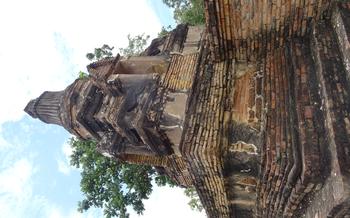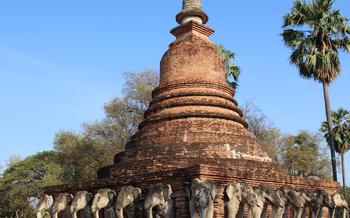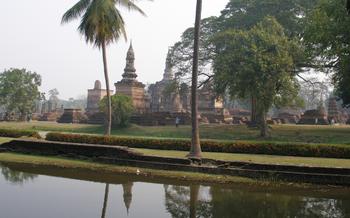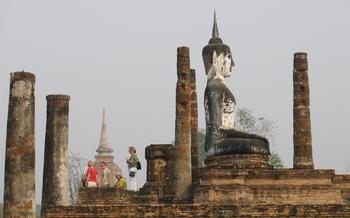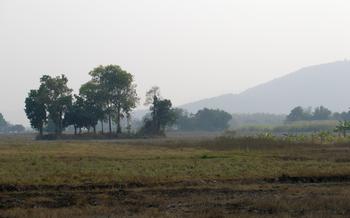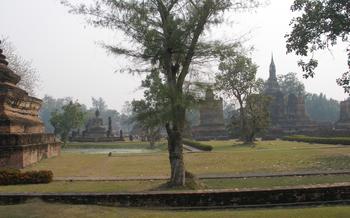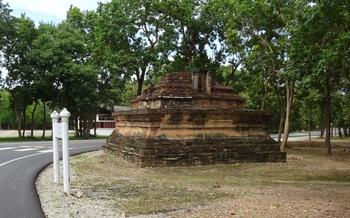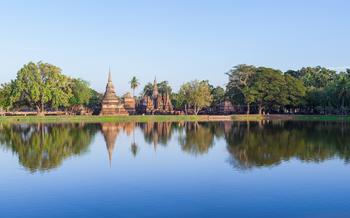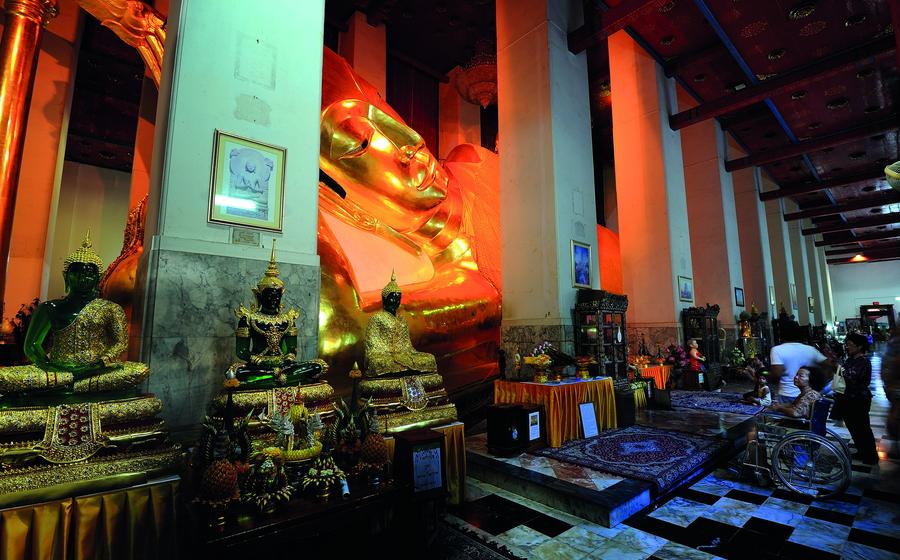
Wat Phra Non
- Historical Significance
- Wat Phra Non Overview
- Exploring the Temple Grounds
- The Main Prang - A Symbol of Royal Authority
- Smaller Prangs
- Viharns (Assembly Halls)
- Chedis (Stupas)
- Buddha Images
- Other Religious Artifacts
- Temple Festivals and Events
- Transportation
- Accommodation
- Food and Dining
- Insider Tip: Uncovering the Hidden Gem of Wat Phra Non
Historical Significance
Sukhothai, meaning "Dawn of Happiness," holds immense historical significance as the first capital of the Kingdom of Siam, established in 1238 by King Ramkhamhaeng the Great. This ancient kingdom played a pivotal role in shaping Thai culture, art, and language. The Sukhothai Kingdom's influence extended beyond its borders, leaving a lasting impact on the region. In recognition of its cultural and historical importance, Sukhothai was designated as a UNESCO World Heritage Site in 1991, attracting visitors from around the world to explore its rich legacy.
Wat Phra Non Overview
Wat Phra Non is an iconic historical temple in Sukhothai, renowned for its unique architectural style and religious significance. The temple features a large central prang, surrounded by several smaller prangs, creating a visually striking composition. The main prang, with its square base, octagonal mid-section, and bell-shaped top, dominates the temple grounds, symbolizing Mount Meru, the sacred mountain in Buddhist cosmology. The smaller prangs, arranged in a symmetrical pattern around the main prang, represent the eight directions in Buddhist cosmology and symbolize the king's power and influence over these directions.
Wat Phra Non holds significant religious importance as a Buddhist temple and a pilgrimage site for Buddhists worldwide. It was once a royal temple during the Sukhothai Kingdom, further emphasizing its historical prominence. Visitors to the temple can explore the various buildings and structures within the complex, including viharns (assembly halls) and chedis (stupas), each with its own unique architectural features and religious significance.
Exploring the Temple Grounds
Wat Phra Non's temple grounds are a treasure trove of architectural wonders and religious significance. The layout of the complex is centered around the towering main prang, surrounded by a series of smaller prangs, viharns (assembly halls), and chedis (stupas). Each structure boasts its own unique features and historical importance.
The intricate carvings and sculptures that adorn the temple buildings are a testament to the artistic prowess of the Sukhothai craftsmen. The walls and pillars are adorned with delicate floral motifs, mythical creatures, and scenes from Buddhist mythology, showcasing the fusion of religious and artistic expression.
Among the various buildings within the temple complex, the viharns hold a special place. These assembly halls served as gathering spaces for monks and worshippers, where they engaged in meditation, chanting, and studying Buddhist scriptures. The viharns are adorned with Buddha images and other religious artifacts, creating an atmosphere of serenity and devotion.
The Main Prang - A Symbol of Royal Authority
The main prang of Wat Phra Non stands tall and majestic in the center of the temple grounds, dominating the skyline with its impressive size and grandeur. This towering structure, reaching towards the heavens, is a testament to the architectural prowess of the Sukhothai Kingdom. Its square base, symbolizing stability and strength, transitions into an octagonal mid-section, representing the eight directions of the Buddhist universe. The prang culminates in a bell-shaped top, reminiscent of the sacred Mount Meru, the mythical abode of the gods in Buddhist cosmology.
The main prang holds deep religious significance as a representation of Mount Meru, the central axis of the Buddhist universe. It is believed that the Buddha ascended to the heavens from the peak of Mount Meru after his enlightenment, making the prang a symbol of spiritual transcendence and liberation. The prang's towering height also serves as a visual reminder of the Buddha's teachings, which guide humanity towards enlightenment and the ultimate goal of nirvana.
Beyond its religious significance, the main prang of Wat Phra Non also carries historical importance as a symbol of royal authority during the Sukhothai Kingdom. The prang was commissioned by King Ramkhamhaeng the Great, the founder of the kingdom, as a symbol of his power and influence. The prang's grand scale and elaborate design were meant to impress visitors and instill a sense of awe and respect for the king's authority.
Today, the main prang of Wat Phra Non remains a powerful symbol of the Sukhothai Kingdom's legacy and a testament to the architectural ingenuity of the Thai people. Visitors to the temple are drawn to its grandeur and beauty, marveling at its intricate carvings and the sheer size of the structure. The main prang stands as a reminder of the kingdom's rich history, its religious devotion, and its enduring influence on Thai culture and architecture.
Smaller Prangs
The smaller prangs that surround the main prang are arranged in a symmetrical pattern, creating a visually striking composition that is unique to Wat Phra Non. These smaller prangs are similar in architectural style to the main prang, featuring square bases, octagonal mid-sections, and bell-shaped tops. However, they are smaller in size and have a more slender appearance.
The smaller prangs hold religious significance as representations of the eight directions in Buddhist cosmology. Each prang represents a different direction, and together they symbolize the Buddha's teachings spreading to all corners of the world. Historically, the smaller prangs also served as symbols of the king's power and influence over the eight directions, reinforcing the Sukhothai Kingdom's authority and reach.
Viharns (Assembly Halls)
The viharns, or assembly halls, at Wat Phra Non are significant architectural features that serve as gathering places for monks and worshippers. These structures are typically rectangular in shape and feature a raised platform with a roof supported by pillars. The walls of the viharns are often adorned with intricate carvings and murals depicting scenes from the life of the Buddha and other religious stories.
The viharns at Wat Phra Non hold great religious significance as they are used for various Buddhist activities, including meditation, chanting, and studying scriptures. Monks and laypeople gather in these halls to deepen their understanding of the Buddha's teachings and to connect with the monastic community.
Historically, the viharns also played an important role as centers of religious and social activities within the Sukhothai Kingdom. They served as venues for community meetings, celebrations, and religious ceremonies. The viharns were often the focal point of village life, bringing people together for both spiritual and social interactions.
Inside the viharns, visitors can find Buddha images and other religious artifacts that contribute to the sacred atmosphere of these spaces. These images are objects of veneration and worship for Buddhists and are believed to represent the presence of the Buddha in the temple.
Chedis (Stupas)
Within the temple complex of Wat Phra Non, visitors can find a variety of chedis, each possessing its own unique characteristics and religious significance. The bell-shaped chedis, with their graceful curves and intricate designs, stand as testaments to the architectural prowess of the Sukhothai era. These chedis were constructed as monuments to enshrine the relics of revered Buddhist monks and teachers, symbolizing the Buddha's teachings and the continuity of the Buddhist lineage.
In contrast to the bell-shaped chedis, the square-based chedis exemplify a more austere and geometric style. These chedis serve as markers of sacred sites and often contain cremated remains of important figures from the Sukhothai period. The presence of these chedis within the temple grounds highlights the significance of Wat Phra Non as a place of remembrance and veneration for both the living and the departed.
Whether bell-shaped or square-based, the chedis at Wat Phra Non stand as silent witnesses to the rich history and spiritual traditions of the Sukhothai Kingdom. They invite visitors to contemplate the impermanence of life and the enduring legacy of the Buddha's teachings, reminding us of the interconnectedness of all beings and the ultimate goal of achieving enlightenment.
Buddha Images
Scattered throughout the temple grounds of Wat Phra Non, visitors will encounter a diverse collection of Buddha images, each possessing unique characteristics and exuding a sense of serenity. These sacred sculptures range from colossal statues that command attention to smaller, intricately carved figures that invite closer examination.
The Buddha images at Wat Phra Non reflect various postures and mudras (hand gestures), each representing a distinct aspect of the Buddha's teachings. Some Buddhas are depicted in the seated meditation posture, symbolizing inner peace and tranquility. Others stand tall, their hands raised in gestures of blessing, protection, or teaching. The diversity of these postures and mudras allows visitors to connect with different facets of the Buddha's teachings and find inspiration in his various manifestations.
Beyond their artistic and religious significance, the Buddha images at Wat Phra Non hold historical importance as representations of the Buddha's presence in the temple. These sacred figures have stood witness to centuries of devotion, prayers, and offerings made by countless pilgrims and worshippers. Each Buddha image carries the energy and collective consciousness of those who have come to seek solace, guidance, and spiritual connection within the temple walls.
Other Religious Artifacts
In addition to the magnificent Buddha images, Wat Phra Non is home to a treasure trove of other religious artifacts that hold significant cultural and historical value. These artifacts provide glimpses into the beliefs, practices, and traditions of the Sukhothai Kingdom. Among the most notable artifacts are stone inscriptions, votive tablets, and amulets.
Stone inscriptions, etched on stone slabs or pillars, are a valuable source of historical information. They record royal decrees, religious teachings, and historical events, offering insights into the political, social, and religious life of the Sukhothai period. Votive tablets, often made of stone or metal, are offerings dedicated to the Buddha or other deities. They typically bear inscriptions expressing gratitude, prayers, or requests for blessings.
Amulets, small objects believed to possess protective or auspicious powers, are another common offering at Wat Phra Non. These amulets are often made of various materials, such as metal, stone, or bone, and are intricately carved with sacred symbols or images of Buddha or other deities. Visitors can purchase these amulets as souvenirs or as a way to seek blessings and protection.
Temple Festivals and Events
Wat Phra Non is renowned for its vibrant temple festivals and events that attract both local and international visitors throughout the year. These festivals offer a unique opportunity to immerse in the rich cultural and religious traditions of Sukhothai.
One of the most significant festivals is the Wai Khru Festival, held annually in November to pay homage to the temple's past abbots and teachers. This festival features colorful processions, chanting, and offerings to the Buddha, creating a lively and spiritual atmosphere.
Another notable event is the Loi Krathong and Yi Peng Festival, celebrated in November. During this festival, visitors can release decorated lanterns into the sky and float krathongs (floating baskets) on the temple's pond, symbolizing the letting go of negative thoughts and emotions.
For those interested in experiencing traditional Thai dance and music, the temple hosts regular performances by local artists. These performances showcase the grace and beauty of Thai classical dance, accompanied by melodious music played on traditional instruments.
To enhance the visitor's experience, guided tours are available, providing insights into the history, architecture, and religious significance of Wat Phra Non. These tours are led by knowledgeable guides who share stories and anecdotes about the temple, bringing its past to life.
Transportation
Reaching Wat Phra Non from Sukhothai town is a breeze, with several transportation options available to suit different preferences and budgets. The temple is located approximately 12 kilometers from the city center and can be reached by songthaew (shared pickup truck), tuk-tuk, or bicycle.
Songthaews, the most budget-friendly option, depart from the Sukhothai Historical Park and charge around 20-30 baht per person. Tuk-tuks, while more expensive, offer a more personalized experience and can be negotiated for a round-trip fare. Renting a bicycle is an excellent choice for those who enjoy exploring at their own pace and costs around 50-100 baht per day.
For those arriving from further afield, such as Bangkok or Chiang Mai, several bus companies offer direct routes to Sukhothai town. From there, you can easily transfer to a songthaew or tuk-tuk to reach Wat Phra Non.
If driving your own vehicle, ample parking space is available at the temple grounds. However, it's worth noting that the temple is located within the Sukhothai Historical Park, which charges an entrance fee of 150 baht for foreigners and 40 baht for Thai nationals.
Accommodation
Sukhothai offers a range of accommodation options to suit different budgets and preferences. From budget-friendly guesthouses to luxurious resorts, there's something for every traveler.
For a truly immersive experience, consider staying in a traditional Thai-style guesthouse. These guesthouses often feature charming wooden bungalows nestled amidst lush gardens, providing a tranquil retreat from the hustle and bustle of the city. They offer basic amenities such as comfortable beds, private bathrooms, and air conditioning, ensuring a comfortable stay.
If you prefer a more luxurious experience, Sukhothai also boasts several upscale resorts. These resorts offer a wide range of amenities, including swimming pools, spas, and fine dining restaurants. They are often located in scenic settings, providing stunning views of the surrounding countryside.
When choosing accommodation in Sukhothai, consider factors such as location, amenities, and budget. If you're on a tight budget, there are several affordable guesthouses within walking distance of Wat Phra Non and other attractions. If you're looking for a more luxurious experience, consider staying at one of the resorts located on the outskirts of the city.
No matter your budget or preferences, Sukhothai has a wide range of accommodation options to make your stay comfortable and memorable.
Food and Dining
Sukhothai's cuisine is a delightful blend of Thai and regional flavors, offering a unique culinary experience to visitors. Among the must-try dishes is khao soi, a rich and creamy coconut noodle soup with a variety of toppings, including chicken, beef, or tofu. Sai oua, a flavorful northern Thai sausage made with pork, herbs, and spices, is another popular dish. For a sweet treat, don't miss sticky rice with mango, a classic Thai dessert that combines the tropical sweetness of ripe mangoes with the chewy texture of glutinous rice.
When it comes to dining options, Sukhothai town offers a range of choices to suit every taste and budget. For an authentic Sukhothai experience, head to one of the many street food stalls that line the streets, offering a variety of local dishes at affordable prices. For a more upscale dining experience, there are several restaurants that serve both Thai and international cuisine.
For those with dietary restrictions, Sukhothai offers a variety of vegetarian and vegan options. Many restaurants have clearly labeled menus indicating which dishes are suitable for vegetarians and vegans. Several vegan-friendly restaurants can be found in Sukhothai town, offering a range of delicious plant-based dishes.
No matter your dietary preferences, Sukhothai's culinary scene has something to offer everyone. From the vibrant flavors of street food to the refined dishes served in upscale restaurants, Sukhothai's cuisine is sure to delight and satisfy your taste buds.
Insider Tip: Uncovering the Hidden Gem of Wat Phra Non
Amidst the grandeur of Wat Phra Non, a hidden gem awaits those who venture beyond the main tourist paths. Tucked away in a secluded corner of the temple grounds lies a serene pond, surrounded by lush vegetation and ancient trees. This tranquil spot offers a unique perspective on the temple's architecture and a chance to experience its tranquility away from the crowds.
To find this hidden gem, follow the path that leads from the main prang towards the eastern side of the temple complex. As you approach the pond, take a moment to appreciate the serene beauty of the surroundings. The water shimmers in the sunlight, reflecting the intricate details of the temple buildings.
This spot is particularly special during the early morning hours when the mist hangs low over the water, creating an ethereal atmosphere. As the sun rises, the golden light illuminates the temple structures, casting long shadows across the pond. This magical moment is perfect for meditation or simply soaking in the peaceful ambiance.
Remember to be respectful of the temple's sacred nature and refrain from swimming or disturbing the wildlife in the pond. This hidden gem is a place to find solace and tranquility, away from the hustle and bustle of the main tourist areas.
